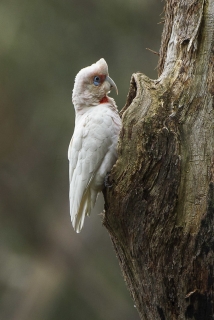Slender-billed Corella |
|
|
Also known as: Corella, Long-billed Corella, Eastern Long-billed Corella or Cockatoo, Slender-billed Cockatoo
Photos
View in GalleryDid You Know?
The Slender-billed Corella is known to use the "sentinel warning system" which employs alert birds warning flocks of approaching danger.Academic Research
Related publications: Cacatua tenuirostrisSpecies Profile
Genus: Cacatua | Species: tenuirostris
Size:
37cm (14.4 in)
Weight:
485-650g (17-22.75 oz)
Subspecies including nominate:
one
Colour Adult:
Both adults in general white in colour; red frontal band, lores and streaking at foreneck; feather bases of head and neck red, becoming paler pink/orange on bases of feathers of mantle, upper back and breast. Eye ring bare and pale blue, covering more area under eye. Eye dark brown.
Colour Juvenile:
As in adult but duller with less far-reaching red markings; pink/orange to bases of feathers in areas mentioned above either minimal or absent; shorter upper mandible.
Call:
Described as quavery, and high toned contact call given continuously in flight; when agitated or alarmed harsh short screech given.
Listen NowVideo Links:
Video 1 | Video 2More Information:
Content Sources:
CITES
BirdLife International
Cornell Lab of Ornithology/Birds of the World
Parrots: A Guide to Parrots of the World, Juniper and Parr, 1998
ML Media Collection Catalogue 128309, Long-billed Corella Cacatua tenuirotstris, Macaulay, Linda, New South Wales, Australia, Oct. 10 2005, Cornell Lab of Ornithology. Site
Parrots of the World, Forshaw and Cooper, 1977. 2010 edition
Parrots of the World, Forshaw, 2006.
Parrots in Aviculture, Low, 1992.
Psittacine Aviculture, Schubot, Clubb and Clubb, 1992.
Photos
View in GalleryDid You Know?
The Slender-billed Corella is known to use the "sentinel warning system" which employs alert birds warning flocks of approaching danger.Academic Research
Related publications: Cacatua tenuirostrisSpecies Care
Captive Status:
Rare
Longevity:
May live more than 50 yrs.
Housing:
Walk-in enclosure, minimum length 4.5m (14.7 ft).
Diet:
Small seed mix: canary, safflower, oats, spray millet, limited sunflower, sprouted, dry or soaked; sprouted pulses and beans, cooked butterbeans and lentils; green leaves of Swiss chard, lettuce, sowthistle, chickweed, etc; vegetables such as: carrot, celery, corn, zucchini, squash, green beans and peas in the pod; fruit such as: apple, orange, cactus fruits, banana, pear and others; nuts such as: walnuts, hazelnuts, pecans, roasted peanuts; complete kibble.
Enrichment:
Provide socialization, lots of chew toy items such as heat sterilized pine cones, wood block and vegetable tanned leather toys, unsprayed pine, fir, willow and elder branches; provide overhead misters or shallow water bowls for bathing.
Nest Box Size:
16" x 16" x 36" (40.6cm x 40.6cm x 91cm) vertical box.
Clutch Size:
2 to 3
Incubation Time:
24-25 days
Fledging Age:
8 weeks
Hatch Weight:
Not recorded.
Peak Weight:
Not recorded.
Weaning Weight:
Not recorded.
Photos
View in GalleryDid You Know?
The Slender-billed Corella is known to use the "sentinel warning system" which employs alert birds warning flocks of approaching danger.Academic Research
Related publications: Cacatua tenuirostrisSpecies Wild Status
World Population:
100,000-500,000
IUCN Red List Status:
Least Concern
CITES Listing:
Appendix II
Threat Summary:
Potentially trapping for wild bird trade and persecution by farmers. Population believed to be increasing, however.
Range:
Found in SE Australia, from SE South Australia east to C Victoria and SW New South Wales. Introduced to urban centres in Australia and Tasmania.
Habitat:
Found up to 400m (1312 ft). Favour tree-lined rivers and creeks running through farmland. In particular river red-gum and bull-oak trees favoured. Also occur in open forest, savanna woodland, farm pastures, paddocks and stubble fields. Not usually found far from water.
Wild Diet:
Feed on corms (mainly non-native), seeds, nuts, berries, roots, bulbs and insects and their larvae. Also may take sown grain and cereal crops.
Ecology and Behaviour:
Noisy and conspicuous. Roosts in trees around water sources. Flocks of up to 2000 birds may gather, outside the breeding season, to use food sources. Feeds on the ground, rooting up different foods, getting soiled and dirty in the process. Fly noisily about before settling down for the evening to roost.
Clutch and Egg Size:
2 to 3 ovate eggs, 33.0 x 25.0mm (1.3 x 1 in).
Breeding Season:
July-October; nest is in tree cavity, with several pairs sometimes nesting in the same tree.
Related Links:
Wikipedia
Research: Foods of the Long-billed Corella
Research: Breeding of the Long-billed Corella at Coomalo Creek, WA
Photos
View in GalleryDid You Know?
The Slender-billed Corella is known to use the "sentinel warning system" which employs alert birds warning flocks of approaching danger.Academic Research
Related publications: Cacatua tenuirostrisMembers Only Resources
Please log-in now to find more research, resources and tools.
Not a Member?
Find more great information:
Gain exclusive access to 600+ pages of additional research, seminars and podcasts, specialists to ask your toughest questions, and dozens of other fun resources - when you become a WPT member.
Join Today >>

































